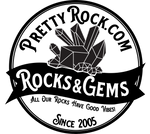How Rough is Graded
We've learned a lot about grading rough and how it translates into gemstones in the past few years. We've developed the chart below to show you what to expect from our gem rough and how the clarity of the rough will carry into the gemstone. Obviously the clarity of the gemstone depends on the skill of the cutter. Orienting the rough and avoiding temperature extremes will affect the actual clarity of the gem. While choosing a gem design that maximizes light while avoiding large dull windows into the stone will affect the perceived clarity of the gem. Nearly all gems have inclusions. Some inclusions are readily apparent. Most inclusions are only visible with scrutiny and are much more noticeable in a loose gem than in a mounted jewelry piece.
Remember, each gem and rough stone are unique. Their inclusions will be in different sizes, shapes, and characteristics.
Parcel Grade
The first column shows our four standard grades for rough for parcels. The A Grade is for the cleanest rough and will create eyeclean or better gems. The B Grade is for stones that may create eyeclean stones but will probably create lightly to moderately included gems. The C grade is for stones that will cut moderately to heavily included gems. This grade is also called the Practice Grade because it gives you gem quality material to cut at the lowest possible price. The D Grade may cut heavily included gems but will primarily be used for cabbing , carving, tumbling, wire wrap or other applications.Hand Select Percentage
The second column shows how our clarity percentage matches up to the four standard grades. This grade is used for our hand select gem rough to give you more specific information on these stones.Gem
The third column shows each standard grade matches up to the typical gemstone clarity grades.Remember, each gem and rough stone are unique. Their inclusions will be in different sizes, shapes, and characteristics.
Facet Rough Clarity Grade Chart
| Grade | Pct | Gem | Description |
A |
100 | FL | No visible inclusions, no flaws, transparent. |
| 99 | IF | No visible inclusions but in the furthermost regions from the finished cutting areas, minor stuff at the outer edges, transparent. | |
| 95 | VVS | Minor inclusions causing minor 5% loss of cutting region to obtain eyeclean gem, transparent. | |
| 90 | VS | Minor inclusions causing minor 10% loss of cutting region to obtain eyeclean gem, transparent. | |
B |
85 | SI1 | Minor inclusions causing minor 15% loss of cutting region to obtain eyeclean gem, transparent. |
| 80 | SI2 | Light inclusions that may not be avoidable in finished gemstone, with care they will not be easily noticed, transparent. | |
C |
75 | I1 | Will cut an included stone, visible to the eye. Stone may be large enough to cut away inclusions for cleaner finished gem, transparent with rare translucent areas. |
| 70 | I2 | Will cut a moderately included stone, easily visible to the eye, transparent with some translucent areas. | |
| 65 | I3 | Will cut a heavily included stone, obvious to the eye and getting crowded, translucent with transparent areas. | |
| 60 | Will cut a heavily included stone with sparse transparent areas, obvious to the eye and getting overcrowded, translucent with rare transparent areas. | ||
D |
55 | Will cut a very heavily included stone with few transparent areas, obvious to the eye and getting overwhelming, translucent material. | |
| 50 | Not suitable for gemstones, excellent choice for cabachons, opaque material. | ||
| 40 | Not suitable for gemstones, good choice for cabachons, minimal light transmits through the stone. | ||
| 20 | Stone may have a rock-like texture, or massive quality, no light transmits through the stone. |
